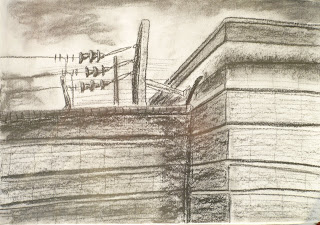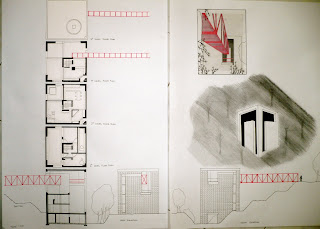For each workshop I tried to incorporate what I had learnt in previous workshops to create a more interesting piece. For example in the second workshop I used red as the only colour in my final presentation which shows the importance of the bridge and that part of the building. In the third workshop I used the experiences I had in the architectural drawing workshop to spread out and in a way quickly plan how my drawing would look on the page which made sure I didnt cramp myself into one corner or just in the centre of the page.
After reflecting on all three workshops I still believe the Fluid thoughts to action workshop helped me gain the most confidence in my work. At the beginning of the workshop I was frightened to start a drawing especially on a such a large piece of paper (A2). However, by the end of the workshop I was able to easily put charcoal to paper and draw.
The Atlas of Colour workshop was also very important as it really opened my eyes to the range of bold colours used in the built environment and that not all presentations have to be plain and minimal in information, images and colour.
In all three workshops time management was also a key factor. Although it seemed at times that the workload was quite a lot it helped me to become more decisive faster and have more confidence. I no longer had the privilege to think things over a long span of time (especially in in-class exercises) but rather what I thought would look good and how I wanted to convey an idea or space in the most successful way but also within a time limit.
All three workshops I undertook in this subject really broadened my ideas on how information can be presented and communicated to colleagues and clients. This knew knowledge will not only help me in my future studies but also in my career in the future as a architect.










































